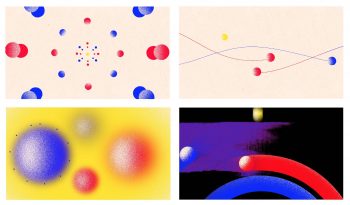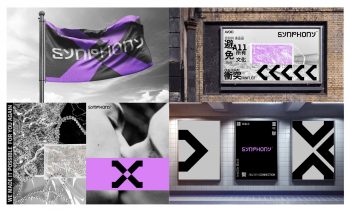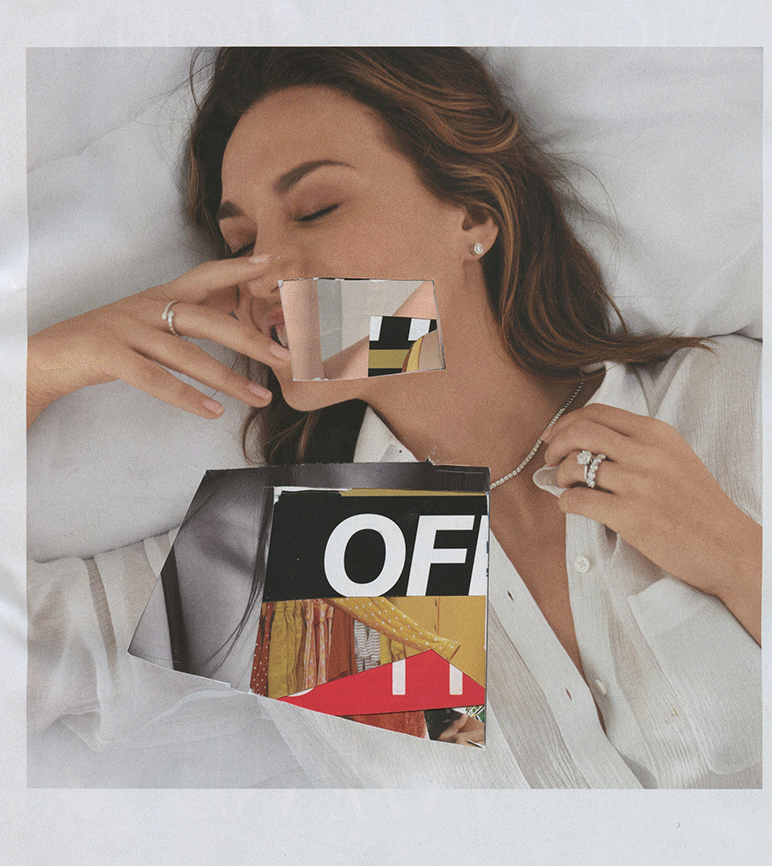The Graduate Practice(a.k.a thesis) presentation is just around the corner. (Sorry for triggering your anxiety MFA2’s.) MFA2’s are trying their best to bring their years at CalArts to a successful conclusion. The Graduate Practice is a very important process for Graphic Design MFA2 students since it is an accumulation of their agenda and skill sets that they honed during the years at CalArts. Now without further ado, let’s hop onto the Graduate Practice journey and take a look at some students’ work.
[Interviewees are as follows: Sam Jones, Emma Berliner, Xiyu Deng.]
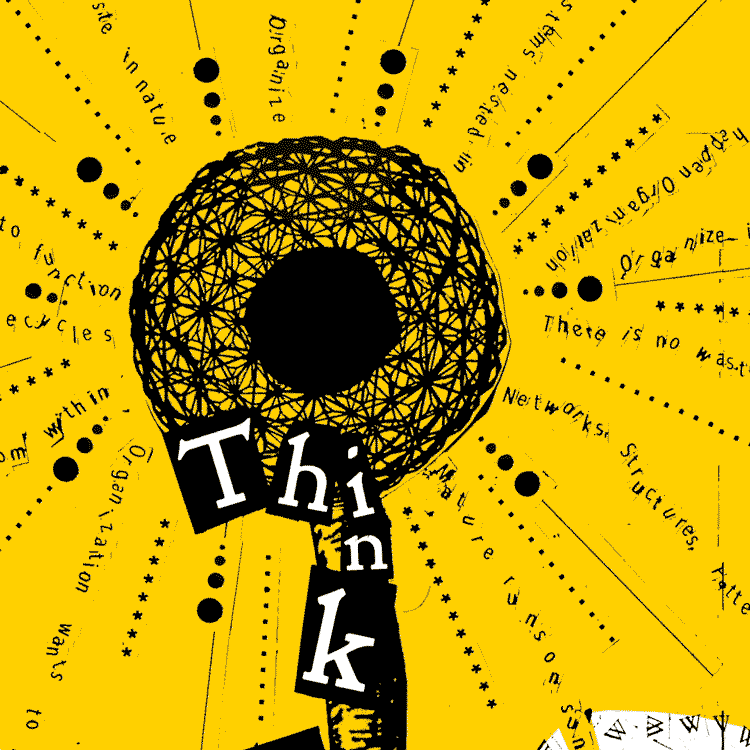
Think Beautiful Ideas for a Sustainable World motion graphic by Sam Jones
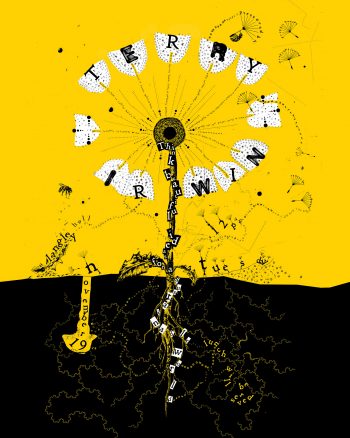
Using nature’s design principles to create a poster. By Sam Jones and Makena Janssen
Name: Sam Jones
Title of Work: Noticing Nature
Can you briefly introduce yourself?
Greetings! My name is Sam and I am in my third year of the CalArts MFA Graphic Design program. I was born in England, but grew up in Cape Town, South Africa. My work primarily involves motion graphics and elements of film.
What is your current thesis about and how did you come up with the idea?
My grad practice centers around our lost connection to nature, and an exploration on how we can improve our sense of wellbeing by bridging that gap. I believe that we need to tell a new story that is more centered around nature and less around our individualistic mindset. One of the ways I have explored this so far is by investigating people that connect to nature in interesting ways—different to that of the average person.
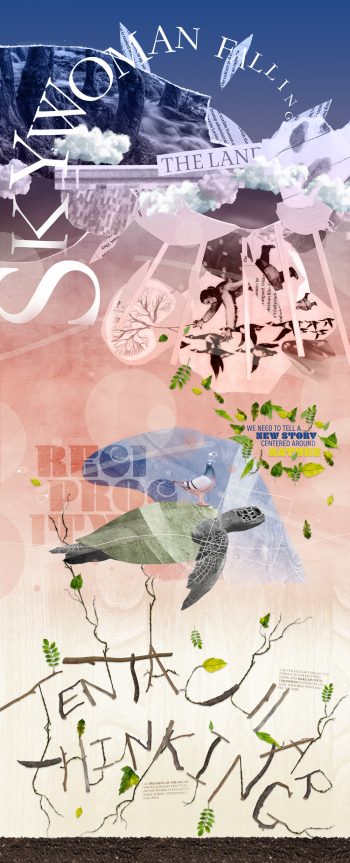
Visually telling a new story centered around nature by Sam Jones
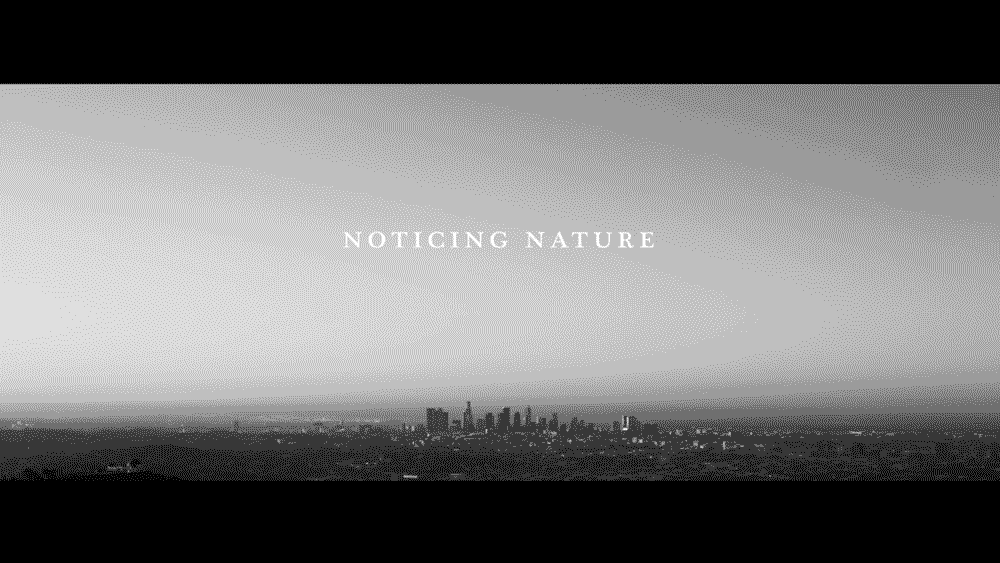
Some shots from the short film Pigeon Man by Sam Jones
Do you feel your thesis is personally connected to you? If it is, what is that connection?
Yes. As a kid I used to go camping often with my parents and this brought me closer to nature. Some of the most important moments of awe that I have experienced in my life have been due to that connection with nature.
What was your biggest challenge so far?
My biggest challenge was settling on a topic. I have a lot of different interests that I initially tried to combine into one idea, but things got a bit complicated. The great part about looking at all these interests though is that it allowed me to have ideas for future projects I’d like to work on.
Any last words?
A recommendation to future GD grad students would be to start researching ideas for your thesis as early as possible, and especially during the summer before your final year. I think researching early helped me get various ideas more formulated in my head, and the chance to cull certain ones. Also, in these hectic times that we live in today we are surrounded by distractions, and I highly recommend putting time aside every week to go outside and reconnect with nature.
Name: Xiyu Deng
Title of Work: Untitled
Can you briefly introduce yourself?
My name is Xiyu Deng. I am an MFA2 student and I started studying here as a PMFA. Before CalArts, I graduated from Vanderbilt University with a bachelor’s degree in mathematics. Besides graphic design, I have a strong passion for photography. Also, I traveled a lot. Meeting new people from a different culture is my favorite thing!
What is your current thesis about and how did you come up with the idea?
My thesis is about miscommunication/
Do you feel your thesis is personally connected to you? If it is, what is that connection?
Yes. (Answered in the previous question.)
What was your biggest challenge so far?
I think transforming a concept into a design project has been my biggest challenge. Technical wise, I am very new to motion graphics. So, making a real motion piece is very challenging for me as well.
Name: Emma Berliner
Title of Work: Looking Backwards into the Future
Can you briefly introduce yourself?
My name is Emma Berliner. I’m a graphic designer, filmmaker and artist currently pursuing my MFA in the Graphic Design program. My background is as a filmmaker; I studied directing during my undergraduate studies at NYU and worked both as a video editor and propmaster in the years directly after school. The combination of these various pursuits ultimately led me to graphic design, specifically motion graphics. I’m also a proud native Angeleno, who loves disco and dogs.
What is your current thesis about and how did you come up with the idea at first?
When I decided to return to CalArts for my graduate degree, I was determined to explore a synthesis between film and design. Personally, I felt that I never neatly fit into any of the categories of “designer” or “director” or “motionographer” and was determined that some space existed for me in between the two disciplines and beyond the formal output of commercial motion graphics. At the most foundational level, this is the underlying concern of my thesis; employing the tropes, tools and techniques of filmmaking to pursue the agenda of graphic design.
The specific projects I’m working on investigate notions of how we experience time; exploring human perception, liminality, structures designed for administrative/systematic uses (like clocks) compared to structures designed to produce creativity and play (like collage or “the school assignment”). My graduate practice thinking initially considered ideas about slowness in relation to the role, value and work of the graphic designer but has since evolved to exploring and examining durational design practices and how graphic design exists (or could exist) in time-based spaces.
One of the projects I’m working on this semester is called 60 days, 60 clocks. This project is a daily clock making ritual over about 60 days, alongside a publication retelling a poetic history of timekeeping devices. The process of making the clocks, a new clock daily, within the constraints of 60 days makes the project as much about the structures of creativity as it is about the structures and systems of time. This collection of clocks are humorous, poetic, and sculptural collages that work to reorient our sense of time & units of measurement. These clocks don’t work well as time keeping devices, and instead work to challenge linear, systematic time to reveal how subjective human time operates. I hope that this project, as well as my larger graduate practice, begins to explore and express the more subjective and poetic spaces within graphic design.
Motion Test videos by Emma Berliner
Do you feel your thesis is personally connected to you? If it is, what is that connection?
Yes, very much. Much of the content of my work deals directly with my personal lineage. Beyond the 60 days, 60 clocks project, I’m currently working on a film about my maternal grandmother. After losing my mother as a very young child, my grandmother was the primary female figure in my life. My earliest design education came from her; watching her put together her outfits. With each dissonant pattern and silhouette, she harmoniously fashioned together a narrative of varied traditions and ideas. From a very young age, I aspired to live a life that involved design in some way, inspired by this early memory. By interviewing my grandmother about her life, the patterning of our family lineage, I hope to speak to my own design lineage, and possibly to a larger collective design lineage.
My grandmother is currently in the early stages of Alzheimers. The film that I’m making, called Finding Izzy, is a portrait of my grandmother struggling with the loss of her memory as we discuss the loss of my mother. The underlying plot of the film is a quest to recover the lost family parrot, named “Izzy,” who disappeared around the time of my mother’s death. So for me, the film is a place where I’m trying to pull together a lot of these distinct ideas; time, memory, personal and collective history, and structures of process. I’m currently working on developing a visual language for the film; I’m trying to create visuals that simultaneously evoke the loss of memory and quest for finding the family parrot. Through this project, I’m trying to provoke what film graphics/motion graphics can look like in the documentary space to challenge the tired talking head aesthetic and slick gfx of commercial documentaries.
What was your biggest challenge so far?
Time!! The biggest challenge for me has been trying to harness the anxiety that comes with the endeavor of making a thesis (which we have been repeatedly asked to not call a “thesis” but rather a “graduate practice,” I think this is the faculty’s sympathetic attempt to help us mitigate this anxiety) while continuing to stay on track and produce visual output.
In the last week, I’ve been thinking a lot about striking a balance between the idea and really loose, generative formal output. I’ve observed that for myself, clarifying the driving idea during the early stages of a project is crucial. I was reminded of an amazing essay I read during Fall semester by J. Abbott Miller called: The Idea is the machine. While the essay primarily talks about book design and sequencing, it lays out a structuralist, idea-driven, ideology for graphic design. For me, this was really exciting!!
If I can come to a particular project with a clarity of purpose and structure, the making of the project happens much quicker and with greater focus, freedom and pleasure. If the idea is half baked, then I find that I spend a lot of time poking around in the dark, blindly hoping to find the right balance between form and content. This blindness only produces more anxiety, and it’s a vicious circle… The process of making is much more enjoyable for me if I put in the time in the beginning developing the idea. Work made with pleasure eminates pleasure.
Any last words?
It was really important to me to create a project or design a circumstance which was going to force me off the computer and get me using my hands. The clock project did that! I guess on some level this is also my small rebellion against Adobe and automation.
Link to Emma’s Graduate Practice Projects
- DIY Collage: https://gradpractice.cargo.site/Interactive-Collage
- Days of Awe; a visual web-essay: https://www.emmaberliner.com/days-of-awe
